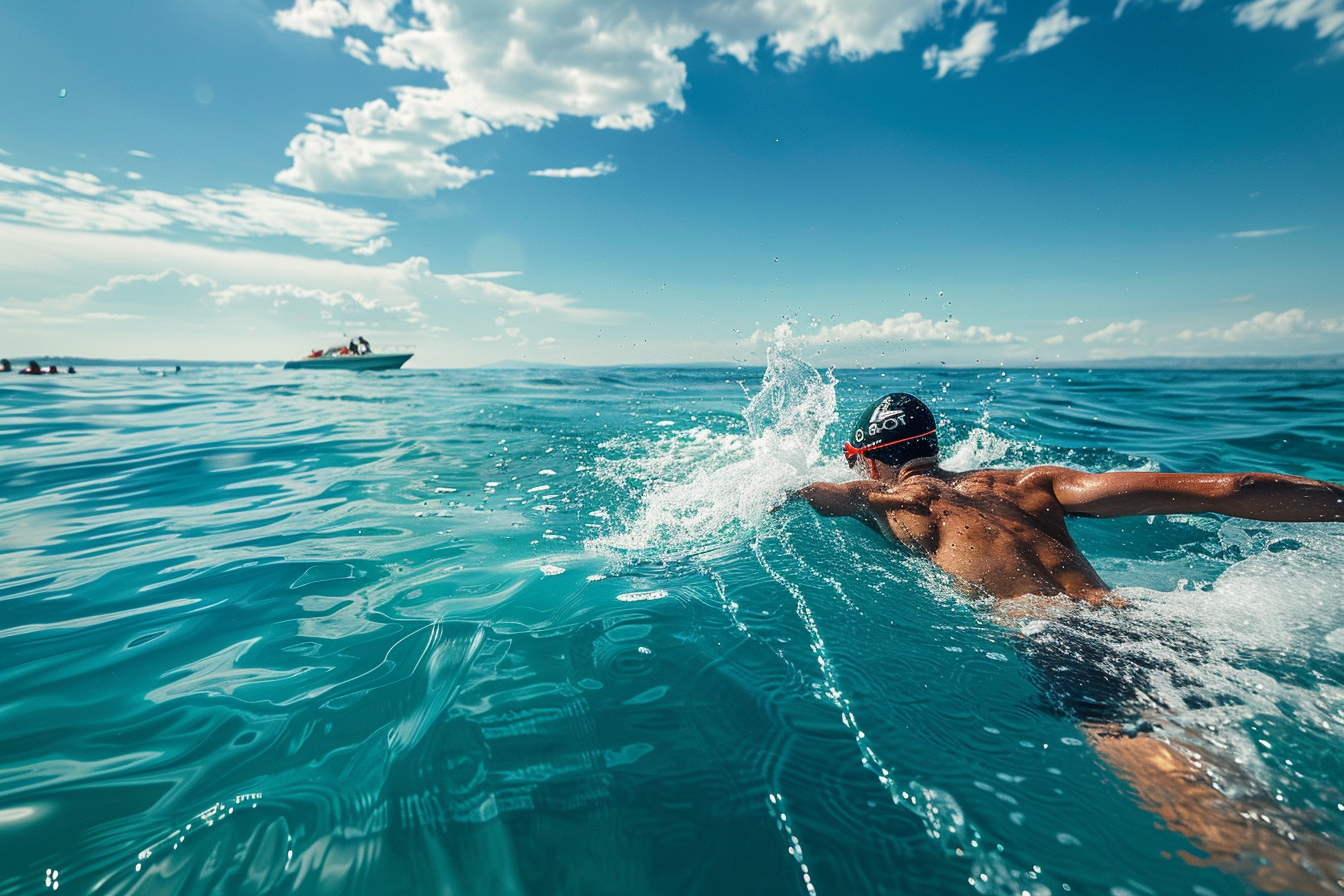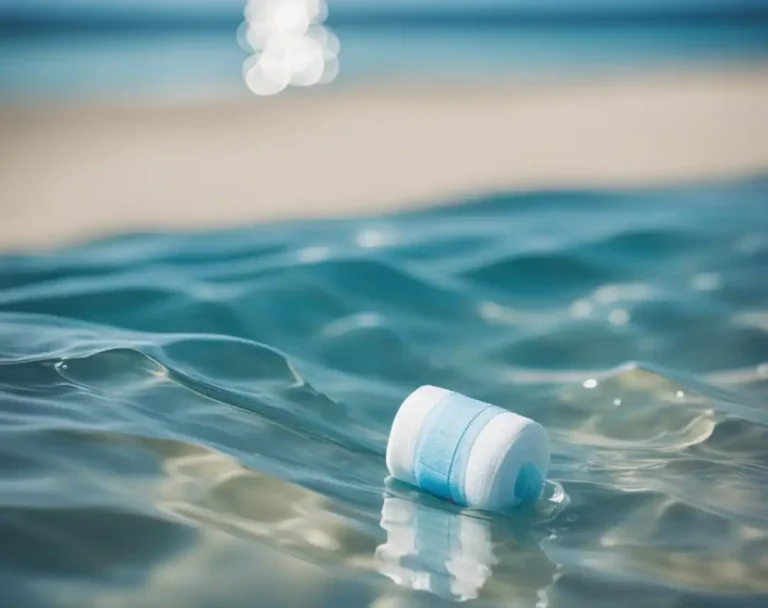Imagine the thrill of swimming in the ocean, where every stroke takes you deeper into the vast, blue mystery. This isn’t just swimming; it’s an adventure where the horizon is your finish line. Whether you’re riding the waves or gliding through calm waters, the ocean offers a unique challenge that promises both exhilaration and serenity. Ready to dive into the endless blue? Let’s embark on the ultimate swimming journey.
Understanding Ocean Swimming
Have you ever felt the thrill of the sea as you plunge into the exhilarating world of ocean swimming? Imagine the salty breeze and the endless horizon stretching before you. The ocean, with its majestic vastness and undulating waves, beckons adventurers like myself to experience the unique realm of open water swimming.
Water Conditions & Temperature:
Before I dive in, I always check the local water conditions. It’s essential to know the sea temperature, which often fluctuates. Adapting to cooler waters than those of a heated pool is part of the excitement but demands proper acclimatization.
Tides & Currents:
Short yet powerful, tides can transform a swim:- High tide: often calmer, deeper waters
- Low tide: potentially more turbulent shallows
Currents, invisible yet forceful, require respect and strategy to navigate. I always swim parallel to the shore to counteract any surprises.
Waves:
Understanding wave patterns prevents unwanted tumbles. Swimmers must time their strokes and breaths with the rise and fall of each wave crest.
Safety Tips:
Lastly, I never swim alone. A buddy system or a nearby lifeguard ensures someone’s always watching out for me. By grasping these elements – tides, currents, waves, and water temperature – I ensure my ocean swims are not only thrilling but safe and enjoyable. There’s truly nothing like the feeling of conquering the open water; it’s just me and the sea, in an endless dance of waves and willpower.
Health and Fitness Benefits
I often marvel at the feeling after a swim in the ocean—my energy levels surge, and there’s a noticeable boost in my mood thanks to those natural endorphins. It’s like the sea washes away my stress, leaving me refreshed and invigorated. Every stroke enhances my strength and endurance while providing an excellent exercise that benefits both body and mind.
- Exercise: Swimming strengthens the heart and lungs, contributing to improved cardiovascular health.
- Endurance: Consistent swims increase stamina and muscle endurance.
- Strength: The water’s resistance builds muscle tone and power.
- Mental Health: The ocean is therapeutic, reducing symptoms of depression and anxiety.
- Stress: Swimming releases endorphins, natural stress fighters, creating a sense of wellbeing.
- Immunity: Invigoration of the immune system occurs, potentially decreasing the likelihood of illness.
- Energy: Regular swimming boosts overall energy levels and can improve sleep quality.
For those with arthritis, the buoyancy of saltwater offers a gentle, supportive environment, easing joint pain and improving mobility. The same goes for skin conditions like psoriasis—seawater, rich in magnesium, can have beneficial effects.
When I submerge myself in the vastness of the ocean, it feels as though I’m tapping into a primal source of health and fitness, contributing greatly to my holistic wellbeing. So next time you’re near the shore, don’t hesitate—dive into the waves and experience the health and fitness perks firsthand!
Safety Guidelines and Precautions
When I hit the beach, I make sure my swim is as thrilling as it is safe. Diving into the ocean’s waves gets my heart racing, but I always prioritize my well-being by sticking to crucial safety guidelines and precautions. With a mix of enthusiasm and caution, I’m here to share key pointers that will keep your swims in the big blue both enjoyable and secure.
Weather and Environmental Awareness
Always check the weather forecast: Before I even leave my house, I confirm that no storms are predicted. Thunder, lightning, and high winds are clear signs to stay away from the water. I also look out for safety flags on the beach; a red flag means the conditions are dangerous.
Understanding Rip Currents
Rip currents are tricky, and recognizing them has been a lifesaver. These narrow, fast-moving belts of water can pull even the strongest swimmers out to sea. If I’m caught in one, I remember to swim parallel to the shore until I’m out of the current’s grip.
Swimming Techniques and Tips
Swimming in the sea requires energy and proper technique. I always use the front crawl because it’s efficient and helps me keep my head above water. It’s important to have good breathing skills and to remain relaxed. If I feel fatigued, I float on my back to catch my breath.
Gear and Protection
I don’t just dive in; I suit up to protect myself. A snug-fitting wetsuit helps me stay warm in cooler waters, and goggles keep the saltwater out of my eyes. I never underestimate the sun, so I apply water-resistant sunscreen to protect my skin from harsh rays.
Local Rules and Regulations
I make it a point to familiarize myself with local swimming rules. Whether it’s designated swimming areas or times when lifeguards are on duty, these regulations are in place to keep everyone safe. I respect these rules not just for my safety but for the safety of those around me.
Interaction with Marine Life
I remember the first time I plunged into the azure waters, surrounded by a mosaic of fish. Feeling both thrilled and humbled by nature, I quickly realized that swimming in the ocean means entering a vast world where humans are merely visitors.
When I swim with the proper guidelines in mind, I witness the silent grace of marine life. I’ve learned that approaching animals with a calm demeanor allows for a peaceful encounter and ensures that I don’t disturb their natural behaviors.
- Respect their space: It’s tempting to reach out and touch, but marine life must not be disturbed. Oceans are their home.
- Swim calmly: Sudden movements can stress animals. Gentle swimming is key.
Interacting with fish while swimming can be mesmerizing. Observing schools of fish shimmering beneath the surface helps me appreciate the diversity of ocean life. Here are a few tips:
- Maintain distance: Keep a respectful distance to avoid disrupting marine ecosystems.
- Be observant: Notice their interactions and movements; it enhances the experience.
Once, a marine biologist shared with me that even my sunscreen could affect marine life. Choosing reef-safe products is crucial for their protection.
Embracing the role of a responsible swimmer means protecting nature. Swimming in the ocean isn’t just a sport; it’s an opportunity to connect with a world so different from mine. Each dive is a chance to witness the astonishing harmony of life beneath the waves, reminding me how my actions can support ocean conservation.
Psychological Effects of Ocean Swimming
Ever immersed yourself in the ocean and felt an inexplicable sense of euphoria? I certainly have! There’s a term for it: the blue mind effect. It’s this serene state when water, specifically the ocean, induces mental wellness. Wild swimming, or taking a dip in natural waters, has been touted for its numerous psychological benefits. Here’s what happens to your mind when you swim in the ocean:
- Stress Reduction: The rhythmic sound of waves coupled with the act of swimming can significantly lower cortisol levels, curbing stress and anxiety.
- Mood Elevation: Ocean swimming triggers the release of dopamine, a neurotransmitter, that’s a natural mood lifter. Yes, nature’s own happiness drug!
Table illustrating psychological changes:
| Before Ocean Swim | After Ocean Swim |
|---|---|
| High stress | Reduced stress |
| Low mood | Elevated mood |
| Mental clutter | Clarity and calm |
Swimming in the ocean is like hitting a reset button for my mental state. There’s a blend of nature’s raw beauty and the physical exertion of swimming that clears my mind and rejuvenates my spirit. It’s something that I find both grounding and exhilarating.
No swim is ever the same; the ocean’s mood shifts and so does mine. If you’ve been on the fence about taking a plunge, consider the profound impact it could have on your mental health. Trust me, your mind will thank you.
Unique Swimming Locations
Imagine plunging into the vast blue, where each location offers a distinctive experience—this is what awaits at the world’s unique swimming locales. Whether it’s the rhythmic dance of the ocean’s waves or the serene stillness of an inland lake, every dip is an adventure of its own.
Popular Beaches and Coasts
Ocean Afficionados: Beaches are iconic for a reason. There’s nothing quite like the feeling of the warm sun over my head, the sound of waves crashing, and the thrill of catching a perfect wave to surf. These coasts should be on every ocean lover’s radar:
- Bondi Beach, Australia — Known for its golden sands and clear blue waters, perfect for sunbathing and surfing.
- Waikiki Beach, Hawaii — Ideal for both beginners and experienced surfers, offering gentle waves and stunning views.
Lakes and Inland Bodies of Water
Lake Enthusiasts: Lakes provide a calmer yet equally extraordinary swimming experience. The Great Lakes, for example, feel like coastal seas but boast freshwater swims without the salty tang. Some to visit:
- Lake Superior — It’s not only impressive in size but also offers crystal clear waters and picturesque surroundings.
- Lake Tahoe — Dotted with intimate beaches, its clarity and the mountainous backdrop are truly mesmerizing.
Mineral-Rich Waters
Mineral Seekers: Swimming in mineral-rich waters like those of the Dead Sea is unforgettable. I marvel at the sensation of buoyancy due to high salt and mineral content including magnesium, similar to an Epsom salt bath but on a grand scale. Key spots include:
- The Dead Sea — It’s not only therapeutic but a unique experience where you can’t help but float.
- Blue Lagoon, Iceland — The geothermal spa is renowned for its rich minerals and healing properties.
Cultural and Recreational Aspects
I can’t help but get a surge of excitement when I think about the ocean. It’s not just the vast, azure expanse that thrills me—it’s the sheer joy and cultural vibrancy of the activities that the ocean beckons us to engage in. From the laughter-filled family gatherings to the adrenaline-pumping competitive events, the ocean is at the heart of a plethora of recreational and cultural experiences.
Family and Community Activities
Picnics on the Beach:
- A time-honored summer tradition where families gather, play, and dine by the ocean’s shore.
- A perfect setting for both relaxation and interactive play, with the ocean providing a refreshing backdrop.
Beach Games:
- Volleyball, frisbee, and sandcastle building often turn a day at the beach into an exercise in fun and creativity.
- Families bond and create lasting memories, the sound of the ocean waves playing their timeless soundtrack.
Competitive Swimming and Events
Open Water Races:
- Competitors test their endurance against the backdrop of the open sea.
- Events like triathlons incorporate swimming as a crucial segment, demanding both skill and strategy.
Local and International Contests:
- Swimmers from around the globe converge on coastal locales to showcase their speed and technique.
- The shared passion for the sport fosters a sense of community and international camaraderie.
The rhythm of the waves coincides with the heartbeat of these cultural and recreational exploits. Whether it’s through leisurely family activities or the rigor of competitive swimming, the ocean offers an inviting canvas for exercise, play, and the joining of communities.
Environmental Considerations and Conservation
I’m thrilled to talk about what’s beneath the waves! It’s vital to understand that our actions have profound effects on marine ecosystems. As a swimmer in the vast blue, I recognize my responsibility in preserving the aquatic wonderland. Boldly stepping into a marine biologist’s flippers, I’ll tell you how seriously I take ocean conservation.
1. Respect Local Wildlife:
Interacting with nature requires mindfulness. I maintain a safe distance from marine life, ensuring I don’t disturb their natural habitat.
2. Sustainable Practices:
Using eco-friendly sunscreen is essential since conventional products contain chemicals harmful to corals.
3. Reducing Pollution:
I urge fellow ocean lovers to limit single-use plastics. Every bottle or bag I avoid means one less pollutant threatening our ocean cousins.
4. Support Conservation Efforts:
I’m always eager to contribute to science-led initiatives, understanding that my support amplifies the work of dedicated researchers.
5. Educate and Inspire:
Sharing knowledge about oceans and their conservation ignites a collective passion for protecting our blue planet.
Together, with vibrant enthusiasm, let’s champion the efforts to keep our oceans teeming with life. Who’s with me? Let’s make every stroke count for nature’s sake!
Practical Advice for Swimming in the Ocean
When I hit the ocean for a swim, my adrenaline surges with the waves. It’s not just about the thrill, though—safety is my mantra. Stick with me to ensure you’re prepping right for this wet wonderland.
Best Times to Swim
Summer reigns supreme for ocean swimming, promising clearer skies and warmer water. I always check the weather forecast in advance. The ideal window? A low tide under clear skies. That’s when the water is most serene, perfect for both novices and seasoned swimmers like me.
Physical Preparations and Conditioning
Swimming in the ocean is a workout like no other. To not just float but thrive, I maintain strong swimmer status with regular exercise. Swimming exercises and endurance training at a local swim school or with a family member are perfect. I ensure my fitness levels are up to par so I can handle any current.
Navigating Hazards
The ocean’s beauty hides sneaky risks—from sudden rocks to deceptive jetties and piers. I learned to recognize the hazards. Never swim alone and always have a lifeguard nearby, ready to jump in should anyone face the threat of drowning.
Community and Social Resources
There’s a tribe for every vibe. Here in the United States, local swim clubs and online groups are teeming with enthusiasts. They not only offer camaraderie but also share essential ocean swimming safety tips. A visit to a swim school can also bolster my skills, ensuring I’m not out of my depth. My advice? Dive into the community before the ocean.
FAQ – Frequently Asked Questions
Is swimming in the ocean safe?
With awareness of weather, currents, and marine life, ocean swimming can be a safe, exhilarating experience.
What equipment do I need for ocean swimming?
A swimsuit, goggles, and sunscreen are essential. Consider a wetsuit for colder waters and a safety buoy for visibility.
How do I deal with ocean currents?
Swim parallel to the shore to escape rip currents and always stay aware of your surroundings and local marine conditions.
Thanks for exploring the majestic world of swimming in the ocean with us. We cherish your insights and stories, so please leave your comments below or connect with us on social media. Let’s keep the waves of conversation going!






